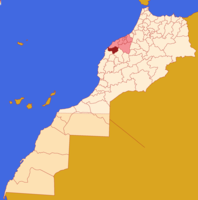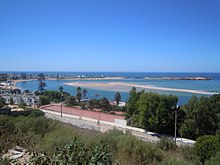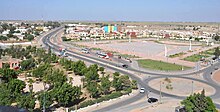Sidi Bennour Province
This article needs additional citations for verification. (February 2025) |
Sidi Bennour Province
إقليم سيدي بنور (Berber languages:ⵜⴰⵙⴳⴰ ⵏ ⵙⵉⴷⵉ ⴰⴱⵉ ⵉⵏⵏⵓⵔ) | |
|---|---|
| Sidi Bennour | |
| Nickname: Doukkala | |
 Location of Sidi Bennour Province within Morocco | |
| Country | |
| Region | Casablanca-Settat |
| Capital | Sidi Bennour |
| Area | |
• Total | 3,007 km2 (1,161 sq mi) |
| Population (2014)[1] | |
• Total | 452,448 |
Sidi Bennour Province (Berber : ⵜⴰⵙⴳⴰ ⵏ ⵙⵉⴷⵉ ⴰⴱⵉ ⵉⵏⵏⵓⵔ Arabic: إقليم سيدي بنور) is one of the Moroccan provinces on the western coast of the country. It was named after Abu Yenour Abd Allah Iben ouchris Al-Doukkali, a Sufi jurist who was a contemporary of the Almoravid state.[2] The province was created in 2009 by separating it from neighboring provinces and belongs to the Casablanca-Settat region north of Marrakesh. It is bordered by the Atlantic Ocean to the west, El Jadida Province to the northwest, Safi Province to the southwest, Rehamna and Youssoufia Province to the southeast, and finally Settat Province and the Oum Er-Rbia River to the northeast. Its capital is Sidi Bennour, and the largest city in the province is Oualidia. Sidi Bennour is often referred to as Sidi Bennour Province to distinguish it from the provincial capital, the city of Sidi Bennour.[3]
Sidi Bennour Province is an administrative division in Morocco, with an area of 116.1 square miles (300,733 km2), and is the thirty-fifth most populous province, with a population of more than 452,538 people.[4] The majority of the population of Sidi Bennour Province lives in the city of Sidi Bennour. It is a center for sugar beet production in the region. Sidi Bennour Province is known for its fertile soil, diverse vegetation, and abundant water. All of these factors have helped the region flourish with its diverse agricultural products such as squash and corn, as well as livestock. It is also known for its economic prosperity, as it has become a destination for all traders from industrial cities such as Fez and Marrakech. It is also distinguished by the presence of Oualidia Beach on the Atlantic coast of the Atlantic Ocean in Morocco, which is considered one of the smallest Moroccan beaches on its Atlantic coast.[5] The Sidi Bennour region is known for its diverse weekly markets throughout the week, including Tnine Chtouka, Tlat Sidi Bennour, Khmis Ksiba, Larbaâ Laaounate, Khmis Zemamra, jamaa Bni Hilal, and Sebt Saiss.
The Sidi Bennour region is considered one of the Moroccan agricultural poles par excellence, with annual production reaching about 185 million liters of milk, 12,000 tons of live weight for meat, 159,000 tons for cattle breeding, and 14,500 hectares of sugar beet, which qualified it to be one of the largest suppliers of milk, sugar and other agricultural products to Morocco.
A number of reasons have qualified this region to occupy this position, the most important of which are: proximity to the influence of the ocean in Oualidia, which provides great opportunities for growing vegetables, the availability of knowledge and skills in agricultural production among farmers, the activity and dynamism of agricultural cooperatives specialized in milk production ; the presence of a network of professional organizations for farmers ( associations, cooperatives, etc.).
Strategic location at the crossroads of trade routes and proximity to major consumption centres ( Casablanca, El Jadida, Marrakech, Safi, Agadir ...), and infrastructure such as ports and industrial zones.
Label
[edit]The name of the region goes back to the personality of Abu Yenour Abd Allah Iben ouchris Al-Doukkali, a Sufi jurist who was a contemporary of the Almoravid state.
Population
[edit]According to the 2014 statistics, the population of the region was 452,538 people, ranking thirty-fifth in terms of population, with a population density of 150.4 per square kilometer. The number of males among them was 229,023 people, representing 50.61 percent, while the number of females was 223,425 people, representing 49.39 percent. The number of foreigners among them was 90 people.[6]
Administrative divisions
[edit]The territorial administration of the region consists of two pashas and two districts with 9 leaderships, two urban groups ( municipalities ) and 23 rural groups.[citation needed]
Pashas
[edit]Municipalities
[edit]Circles
[edit]Rural groups
[edit]Constituency Sidi Bennour
[edit]- Bni Hilal
- Bni Tsiriss
- Bouhmame
- Jabria
- Khmis Ksiba
- Koudiat Bni Dghough
- Kridid
- Laagagcha
- Laamria
- Laaounate
- Laatatra
- Lmechrek
- Metrane
- M'Tal
- Oulad Amrane
- Oulad Boussaken
- Oulad Si Bouhya
- Tamda
Constituency Zemamra
[edit]Landmarks
[edit]The most important landmarks of the region are the Dome of Sidi Bennour, the Dome of Sidi Boussaken, the Kasbah of Oualidia, the Kasbah Boulaouane, the Kasbah Khmis Ksiba, and a type of heritage building called Tazota.[citation needed]
It also contains huge natural landscapes such as the Oualidia Beach, Ain El Ghar Forest, Bouhmame Forest, Oulad Boussaken Forest, and Jbel Lakhdar, in addition to the shrines located in the region, including the shrine of Abu Yenour Al-Doukkali, the shrine of Abu Hafs Omar bin Ali Al-Daghoghi, the shrine of Abdul Aziz bin Yafo, and others...[citation needed]
Flags
[edit]Among the most famous artistic figures are the musician and singer Fatna Bent Lhoucine and the singer Abdelaziz Stati.[citation needed]
Sports
[edit]Among the most famous sports clubs in the Sidi Bennour region are Fath Sidi Bennour Club in the city of Sidi Bennour, Amal Sidi Bennour Club in the city of Sidi Bennour as well, and RCA Zemamra in the city of Zemamra.[citation needed]
the date
[edit]
The fifties of the last century were the beginning of oyster farming in the city, specifically in 1954 at the hands of the Frenchman Banclos Al-Bashir, who converted to Islam, settled in Morocco, and established " Pond " or the seventh station as the first station for oyster farming and valuation in the city.[citation needed]
Chance alone led Banclo to try to farm oysters in Lake Oualidia, after he saw with an expert's eye the potential of the lake and its availability of a suitable environmental environment similar to the famous French stations for farming oysters.[citation needed]
The nature of the formation of Lake Oualidia, as a narrow waterway similar to a river separated from the sea by sand dunes, and the course of this " river " which is parallel to the ocean and its waters meet at high tide, has turned it into a suitable environment for the growth and reproduction of this type of shellfish.[citation needed]
Panclo imported seeds, or " seeds " as professionals call them, or baby oysters from Japan, and planted them in the Oualidia Lake.[citation needed]
The surprise was amazing, the young Japanese oysters quickly adapted to the Oualidia waters, began to feed on plankton, and lived to transform into oysters of different sizes. This experience was the reason for transforming Oualidia into the capital of oyster production in Morocco, and many French and Moroccans alike settled in the region to produce Oualidia oysters, which are distinguished by their special taste.[7]
Geography
[edit]
Sidi Bennour province is bordered to the east by El Jadida province, to the west by the Atlantic Ocean, to the north by Settat province, and to the south by Safi province. The province consists of 23 districts, and the total area is 300,733 km2, making it the thirty-fifth largest in terms of population.
The Sidi Bennour region contains several forests, the most important of which are Ain El Ghar Forest, Bouhmame Forest, and Oulad Boussaken Forest. It is also distinguished by the presence of the last elevation of the Atlas Mountains called the Jbel Lakhdar. The region also extends along a 30 km coastal strip on the Atlantic Ocean.
The capital of the region is Sidi Bennour, with a population of 55,815 people. The city of Oualidia is the largest city in the region, with a population of 18,616 people. Another large city is Zemamra, which is close to the commune of Laghnadra.
Economy
[edit]

The Doukkala sugar factory, a unit of the Cosumar group located in Sidi Bennour, is an important socio-economic hub in the region. The factory confirms each year its ambition to strengthen its position as a driver of the regional economy through a responsible and ecological citizen commitment embodied in concrete and creative actions for shared value between all the partners of its economic system : farmers, suppliers, transport operators, civil society ...
After investing hundreds of millions of dirhams to modernize its industrial machinery, the Doukkala sugar factory has acquired new modern equipment that will enable it to improve overall performance, which will benefit all stakeholders in its economic system. These measures have enabled, since the 2016 season, to obtain exceptional results with a record production of 232,000 tons of sugar and a sweetness rate of the harvested beets of 18%.
The results achieved are comparable to those recorded by the best sugar beet factories in the world, as they have increased farmers’ incomes by 25% compared to the previous season.
The sugar factory continues its efforts to achieve a competitive and sustainable performance for the sugar chain activity in the region. The environmental dimension is at the heart of the " corporate social responsibility " strategy. In accordance with the commitments aimed at protecting the environment and the optimal rationalization of the use of natural resources, other new investments have been made with a financial envelope of 40 million dirhams. These efforts have made it possible in particular to reduce liquid waste and rationalize water consumption, which has decreased by about 86%.
In addition, two new steam generators and a turbo-generator will be operational starting in the 2017 season. The steam generators will be equipped with state-of-the-art emission control systems that meet the most stringent requirements in the field, and the turbo-generator will improve our performance in terms of energy efficiency. These projects have required the intervention of more than 15 companies from all professional bodies, including 13 local companies, and more than 300 technicians and engineers permanently present on site for nearly two years.
For nearly 50 years, the Doukkala sugar factory has been an important economic player in the region. Located at the entrance to Sidi Bennour, the factory employs around 180 permanent workers throughout the year and 1,000 seasonal workers during the off-season. It also contributes to improving the incomes of 20,000 partner farmers who supply the sugar factory with sugar beets grown on an area of 20,000 hectares each season. In 2016, their incomes increased by an average of 25% compared to the previous season.[8]
As for the city of Zemmama, it is considered a bank for the Sidi Bennour region, in terms of agricultural and animal products, due to its enormous natural potential, in terms of agriculture and livestock breeding. It has the best soil in Morocco, which is the soil of the Ters, which is exploited throughout the seasons. This is what made the region always green, as it is considered a pioneer in the production of meat and wheat. It also has an important market called the Souk Khmis Zemmama .
The main resources of Oualidia are oysters, as well as fishing, tourism and agriculture. The resort of Oualidia has one of the best protected beaches on the North Atlantic coast, which gives it a tourist attraction. Oualidia is the first oyster farming point in Morocco, and therefore it is advanced in this field.
Universities
[edit]The Higher School of Technology of Sidi Bennour is located in the city of Sidi Bennour and was established in 2016. It has about 13,175 students. It is a public university.
References
[edit]- ^ Census 2014. (in Arabic and French)
- ^ "SEAFRONT VILLAS FOR SALE IN THE SIDI-BENNOUR REGION, MOROCCO". www.romolini.co.uk. Archived from the original on 18 September 2020. Retrieved 2022-10-12.
- ^ Jilweb. "المجلس العلمي المحلي لسيدي بنور". www.majlissidibennour.net (in French). Archived from the original on 10 February 2020. Retrieved 2022-10-12.
- ^ "سيدي بنور - الأقاليم و العمالات | جهة الدار البيضاء-سطات". # (in Arabic). Retrieved 2022-10-12.
- ^ Oualidia Beach - Oualidia Forum - TripAdvisor Archived 2013-03-01 at the Wayback Machine
- ^ "اقليم مدينة سيدي بنور". www.ahdaf1.com. Archived from the original on 13 October 2022. Retrieved 2022-10-12.
- ^ التحرير, فريق (2021-12-16). "طبيعتها الساحرة وثروتها الفريدة "جذبت" أنظار العرب والعالم.. ماذا تعرف عن عاصمة المحار "كنز" المغرب المثير للدهشة؟". خبر بوست (in Arabic). Archived from the original on 13 October 2022. Retrieved 2022-10-12.
- ^ "معمل السكر دكالة بمجموعة كوسومار يعلن عن اقتناء تجهيزات جديدة ذات تكنولوجيا نظيفة – ألجديدة 24" (in Arabic). Archived from the original on 13 October 2022. Retrieved 2022-10-12.

